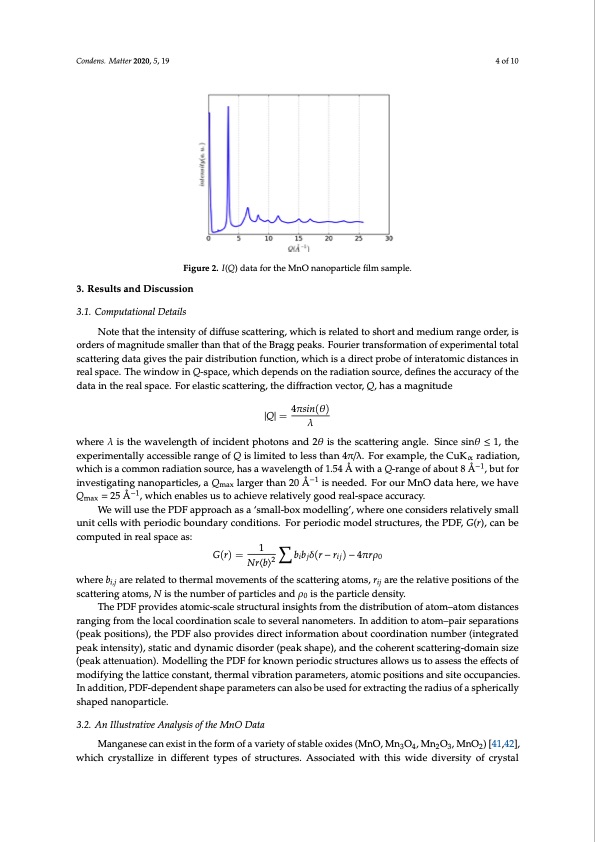
PDF Publication Title:
Text from PDF Page: 004
Condens. Matter 2019, 4, x FOR PEER REVIEW 4 of 10 effects of other factors that contribute to the peak width such as instrumental resolution, temperature Caonddenms. iMcraottsertr2a0i2n0,n5o, 1t9withstanding. 4 of 10 Figure 2. I(Q) data for the MnO nanoparticle film sample. Figure 2. I(Q) data for the MnO nanoparticle film sample. 33..ReessullttssandDiscussion 33.1.1..CoompputtaattiionallDdetaiills Nooteteththaattththeeinintteennssiittyyooffdiifffufusseessccaattteerriing,,whiichiisrrellattedttoshorttandmediumrange order,,is oirsdeorsdoefrsmoafgmniatgundietusdmeaslmleraltlhearnthtahnatthofathoef tBhreagBgrapgegakpse.aFkos.uFroieurrtirearntrsafonrsmfoartmioantiofneoxfpexrpimereinmtaenl toaltal sctoatatelrsincagttdearitnagidvaetsathgeivpeasirthdeistpraibirutdioisntrfiubuntcitoionnf,uwnhctiicohni,swahdiicrhecitsparodbiereocftinptreorbaetoomficindteisrtatnocmeiscin redaisltsapnaccees. iTnhreawlisnpdaocwe. iTnhQe -wspinadceo,wihnicQh-sdpeapceen,dwshoinchthdepraednidastion sthoeurcaed,idateifionesotuhrecea,ccduerfianceysotfhtehe dactcauirnacthyeorfetahlesdpatcaei.nFtohreerleaasltiscpsacaet.tFeorirnegla, sthtiec sdciafftrtaecritniogn, tvhecdtoifrf,rQac,thioans vaemctaogr,nQit,uhdaes a magnitude |�| = �����(�) 4πsin(θ) � |Q| = where λ is the wavelength of incident photons and 2� is the scattering angle. Since sin� ≤ 1, the experimentally accessible range of Q is limited to less than 4π/λ. For example, the CuKα radiation, where λ is the wavelength of incident photons and 2θ is the scattering angle. Since sinθ ≤ 1, the which is a common radiation source, has a wavelength of 1.54 Å with a Q-range of about 8 Å–1, but experimentally accessible range of Q is limited to less than 4π/λ. For example, the CuKα radiation, for investigating nanoparticles, a Qmax larger than 20 Å–1 is needed. For our MnO data here, w−1e have which is a common radiation source, has a wavelength of 1.54 Å with a Q-range of about 8 Å , but for Qmax = 25 Å–1, which enables us to achieve relatively go−1od real-space accuracy. investigating nanoparticles, a Qmax larger than 20 Å is needed. For our MnO data here, we have We wil−l1use the PDF approach as a ‘small-box modelling’, where one considers relatively small Qmax = 25 Å , which enables us to achieve relatively good real-space accuracy. unit cells with periodic boundary conditions. For periodic model structures, the PDF, G(r), can be We will use the PDF approach as a ‘small-box modelling’, where one considers relatively small computed in real space as: G(r) = Nr⟨b⟩2 bibjδ(r − rij) − 4πrρ0 where bi,j are related to thermal movements of the scattering atoms, rij are the relative positions of the scattering atoms, N is the number of particles and ρ0 is the particle density. where bi,j are related to thermal movements of the scattering atoms, rij are the relative positions of the computed in real space as: unit cells with periodic boundary conditions. For periodic model structures, the PDF, G(r), can be λ �(�)= 1 �� ����−� �−4��� 1�� �� � �� < � > 2 The PDF provides atomic-scale structural insights from the distribution of atom–atom distances scattering atoms, N is the number of particles and ρ0 is the particle density. ranging from the local coordination scale to several nanometers. In addition to atom–pair separations The PDF provides atomic-scale structural insights from the distribution of atom–atom distances (peak positions), the PDF also provides direct information about coordination number (integrated ranging from the local coordination scale to several nanometers. In addition to atom–pair separations peak intensity), static and dynamic disorder (peak shape), and the coherent scattering-domain size (peak positions), the PDF also provides direct information about coordination number (integrated (peak attenuation). Modelling the PDF for known periodic structures allows us to assess the effects peak intensity), static and dynamic disorder (peak shape), and the coherent scattering-domain size of modifying the lattice constant, thermal vibration parameters, atomic positions and site (peak attenuation). Modelling the PDF for known periodic structures allows us to assess the effects of occupancies. In addition, PDF-dependent shape parameters can also be used for extracting the radius modifying the lattice constant, thermal vibration parameters, atomic positions and site occupancies. of a spherically shaped nanoparticle. In addition, PDF-dependent shape parameters can also be used for extracting the radius of a spherically shaped nanoparticle. 3.2. An Illustrative Analysis of the MnO Data Manganese can exist in the form of a variety of stable oxides (MnO, Mn3O4, Mn2O3, MnO2) [41,42], which crystallize in different types of structures. Associated with this wide diversity of crystal Commented [ preserved.PDF Image | Structure of Manganese Oxide Nanoparticles Extracted via Pair Distribution Functions

PDF Search Title:
Structure of Manganese Oxide Nanoparticles Extracted via Pair Distribution FunctionsOriginal File Name Searched:
condensedmatter-05-00019-v2.pdfDIY PDF Search: Google It | Yahoo | Bing
Sulfur Deposition on Carbon Nanofibers using Supercritical CO2 Sulfur Deposition on Carbon Nanofibers using Supercritical CO2. Gamma sulfur also known as mother of pearl sulfur and nacreous sulfur... More Info
CO2 Organic Rankine Cycle Experimenter Platform The supercritical CO2 phase change system is both a heat pump and organic rankine cycle which can be used for those purposes and as a supercritical extractor for advanced subcritical and supercritical extraction technology. Uses include producing nanoparticles, precious metal CO2 extraction, lithium battery recycling, and other applications... More Info
| CONTACT TEL: 608-238-6001 Email: greg@infinityturbine.com | RSS | AMP |